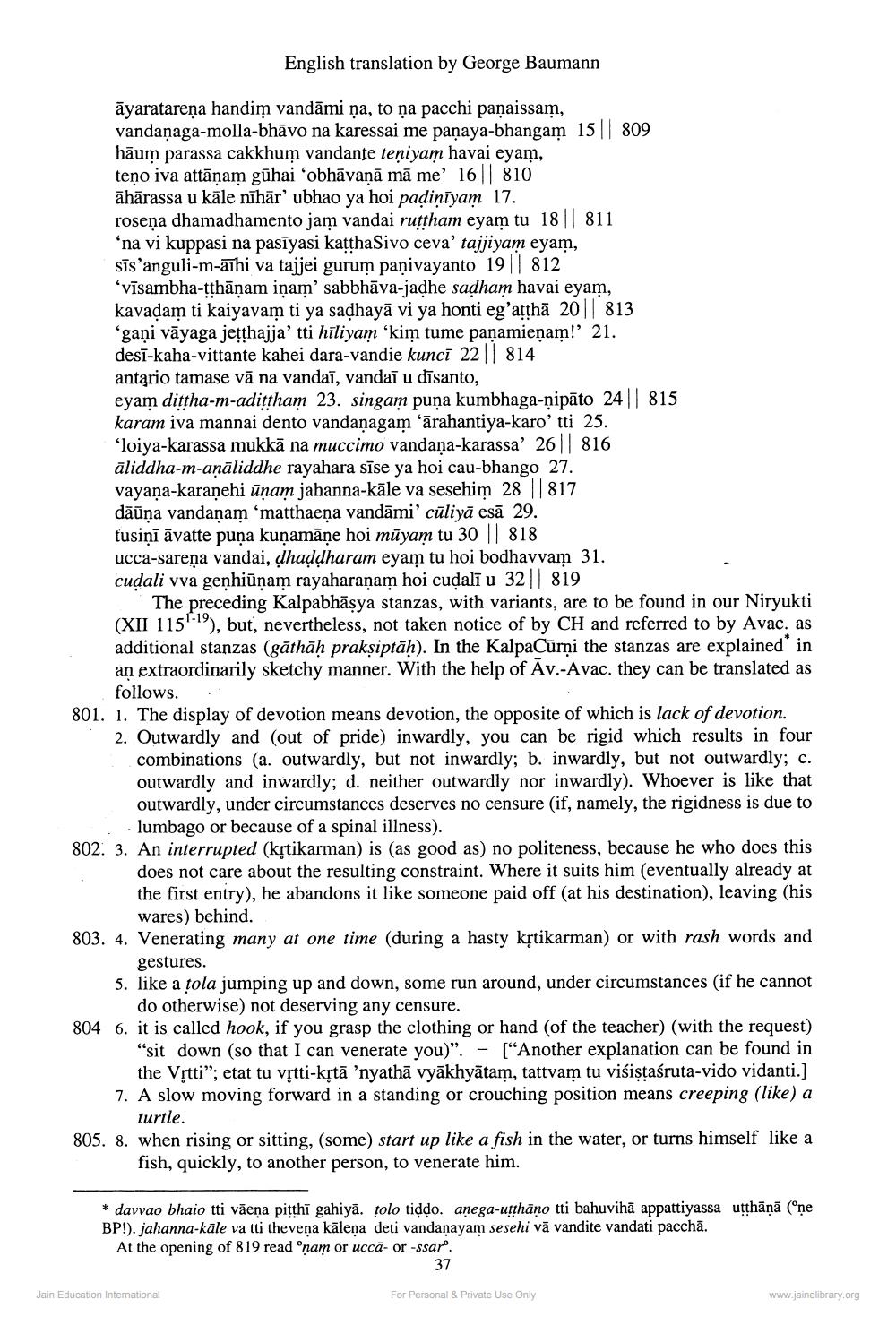________________
English translation by George Baumann
āyaratarena handim vandāmi ņa, to ņa pacchi paņaissam, vandaņaga-molla-bhāvo na karessai me paņaya-bhangam 15 || 809 hāum parassa cakkhum vandante teniyam havai eyam, teņo iva attāṇam gūhai ‘obhāvanā mā me' 16|| 810 āhārassa u kāle nīhār' ubhao ya hoi padiniyam 17. roseņa dhamadhamento jam vandai ruttham eyam tu 18 || 811 'na vi kuppasi na pasīyasi katthaSivo ceva' tajjiyam eyam, sīs'anguli-m-āīhi va tajjei gurum paņivayanto 19|| 812
vīsambha-tthānam inam' sabbhāva-jadhe sadham havai eyam, kavadam ti kaiyavam ti ya sadhayā vi ya honti eg'atthā 20|| 813 ‘gaņi vāyaga jetthajja' tti hīliyam ‘kim tume pañamieňam!' 21. desī-kaha-vittante kahei dara-vandie kunci 22 || 814 antario tamase vā na vandaī, vandai u disanto, eyam dittha-m-adittham 23. singam puņa kumbhaga-nipāto 24|| 815 karam iva mannai dento vandanagam ‘ārahantiya-karo'tti 25. ‘loiya-karassa mukkā na muccimo vandana-karassa' 261 816 āliddha-m-anāliddhe rayahara sīse ya hoi cau-bhango 27. vayaņa-karanehi ūņam jahanna-kāle va sesehim 28 || 817 dāüņa vandanam 'matthaeņa vandāmi' cüliyā esā 29. tusiņī āvatte puņa kuņamāṇe hoi mūyam tu 30 || 818 ucca-sareņa vandai, dhaddharam eyam tu hoi bodhavvam 31. cudali vva genhiūņam rayaharaṇam hoi cudalī u 32 || 819
The preceding Kalpabhāşya stanzas, with variants, are to be found in our Niryukti (XII 1151-19), but, nevertheless, not taken notice of by CH and referred to by Avac. as additional stanzas (gāthāḥ prakṣiptāh). In the KalpaCūrņi the stanzas are explained in an extraordinarily sketchy manner. With the help of Av.-Avac. they can be translated as
follows. . 801. 1. The display of devotion means devotion, the opposite of which is lack of devotion.
2. Outwardly and (out of pride) inwardly, you can be rigid which results in four
combinations (a. outwardly, but not inwardly; b. inwardly, but not outwardly; c. outwardly and inwardly; d. neither outwardly nor inwardly). Whoever is like that outwardly, under circumstances deserves no censure (if, namely, the rigidness is due to
lumbago or because of a spinal illness). 802. 3. An interrupted (krtikarman) is (as good as) no politeness, because he who does this
does not care about the resulting constraint. Where it suits him (eventually already at the first entry), he abandons it like someone paid off (at his destination), leaving (his
wares) behind. 803. 4. Venerating many at one time (during a hasty krtikarman) or with rash words and
gestures. 5. like a tola jumping up and down, some run around, under circumstances (if he cannot
do otherwise) not deserving any censure. 804 6. it is called hook, if you grasp the clothing or hand (of the teacher) (with the request)
"sit down (so that I can venerate you)". - (“Another explanation can be found in
the Vstti”; etat tu výtti-kstā 'nyathā vyākhyātam, tattvam tu visistaśruta-vido vidanti.) 7. A slow moving forward in a standing or crouching position means creeping (like) a
turtle. 805. 8. when rising or sitting, (some) start up like a fish in the water, or turns himself like a
fish, quickly, to another person, to venerate him.
* davvao bhaio tti vāeņa pitthī gahiya. tolo tiddo. anega-utthāno tti bahuvihā appattiyassa utthāņā (ne BP!).jahanna-kāle va tti theveņa kāleņa deti vandanayam sesehi vă vandite vandati pacchā. At the opening of 819 read onam or uccă- or -ssaro.
37
Jain Education International
For Personal & Private Use Only
www.jainelibrary.org




